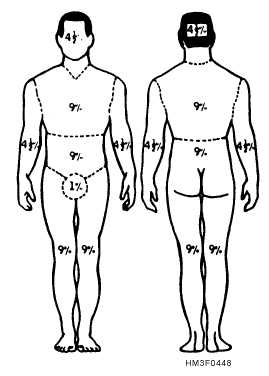be estimated by the depth, extent, and location of the
burn, the age and health of the victim, and other
medical complications.
Classification of Severity
Burns are classified according to their depth as
first-, second-, and third-degree burns (as shown in
figure 4-47).
FIRST-DEGREE BURN.—With a first-degree
burn, the epidermal layer is irritated, reddened, and
tingling. The skin is sensitive to touch and blanches
with pressure.
Pain is mild to severe, edema is
minimal, and healing usually occurs naturally within a
week.
SECOND-DEGREE BURN.—A second-degree
burn is characterized by epidermal blisters, mottled
appearance, and a red base. Damage extends intobut
not throughthe dermis. Recovery usually takes 2 to
3 weeks, with some scarring and depigmentation. This
condition is painful. Body fluids may be drawn into
the injured tissue, causing edema and possibly a
“weeping” fluid (plasma) loss at the surface.
THIRD-DEGREE BURN.—A third-degree burn
is a full-thickness injury penetrating into muscle and
fatty connective tissues, or even down to the bone.
Tissues and nerves are destroyed. Shock, with blood in
the urine, is likely to be present. Pain will be absent at
the burn site if all the area nerve endings are destroyed,
and the surrounding tissue (which is less damaged)
will be painful. Tissue color will range from white
(scalds) to black (charring burns).
Although the
wound is usually dry, body fluids will collect in the
underlying tissue. If the area has not been completely
cauterized, significant amounts of fluids will be lost by
plasma “weeping” or by hemorrhage, thus reducing
circulation volume. There is considerable scarring and
possible loss of function.
Skin grafts may be
necessary.
Rule of Nines
Of greater importance than the depth of the burn in
evaluating the seriousness of the condition is the extent
of the burned area. A first-degree burn over 50 percent
of the body surface area (BSA) may be more serious
than a third-degree burn over 3 percent. The Rule of
Nines is used to give a rough estimate of the surface
area affected.
Figure 4-48 shows how the rule is
applied to adults.
Other Factors
A third factor in burn evaluation is the location of
the burn. Serious burns of the head, hands, feet, or
genitals will require hospitalization.
The fourth factor is the presence of any other
complications, especially respiratory tract injuries or
other major injuries or factors.
4-57
Figure 4-47.—Classification of burns.
Figure 4-48.—Rule of Nines.




